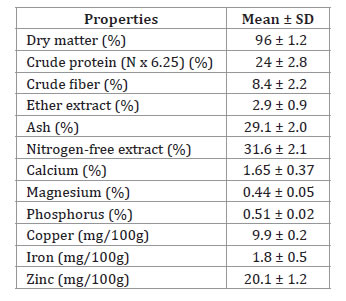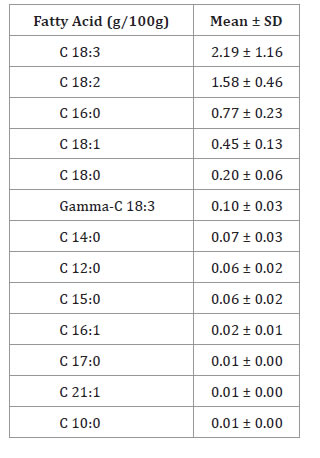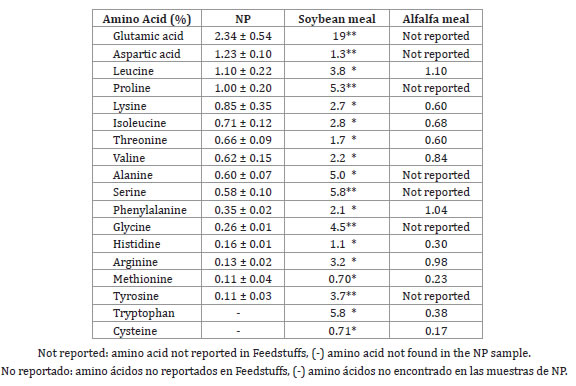
ORIGINAL ARTICLE
Development and characterization of nettle-leaves powder (Urtica urens) as a potential supplement for animal feed
Desarrollo y caracterización de un preparado en polvo de hojas de ortiga (Urtica urens) como un potencial suplemento para alimentación animal
Francisca Arros1, Camila Garrido1, Carolina Valenzuela1*
1 Universidad de Chile. Facultad de Ciencias Veterinarias y Pecuarias. Casilla 2. La Granja. Santiago. Chile. * cvalenzuelav@u.uchile.cl
Originales: Recepción: 04/03/2019 - Aceptación: 30/07/2019
ABSTRACT
Nettle plants in Chile are an underutilized resource. Its use in animal nutrition is also limited. In addition, information about its composition (specifically fatty acids and aminoacids) is scarce. The objective of this work was to develop and characterize nettleleaves powder (NP). This powder was characterized by means of proximate chemical analysis. Its concentration of minerals, and composition profiles for fatty acids and aminoacids, was determined. NP showed high dry basis content of proteins (24%) and nitrogen-free extract (32%), whereas crude fiber concentration was low (8.4%). Also, NP showed high concentrations of ash (29%), and mineral, specially for calcium (1.65%) and zinc (20 mg/100g of NP). Additionally, glutamic and aspartic acids, as well as leucine, were the major types of aminoacids found in NP. In conclusion, though nettle plants are an under-utilized resource, the elevated content of protein found in powders prepared from their leaves might become a compelling reason to include them as a protein supplement in animal diets.
Keywords: Urtica urens; Chemical composition; Minerals; Aminoacids; Fatty acids
RESUMEN
Las plantas de ortiga en Chile son un recurso subutilizado y su uso en nutrición animal es limitado. Además, la información sobre su composición de ácidos grasos y aminoácidos es escasa. El objetivo de este trabajo fue desarrollar y caracterizar un preparado en polvo de hojas de ortiga (NP). El cual se caracterizó por análisis químico proximal, determinación de su concentración de minerales y perfiles de composición de ácidos grasos y aminoácidos. El NP mostró un alto contenido en base seca de proteínas (24%) y extracto libre de nitrógeno (32%), mientras que la concentración de fibra bruta fue baja (8,4%). Además, NP mostró altas concentraciones de ceniza (29%) y minerales, como calcio (1,65%) y zinc (20 mg/100 g de NP). Además, los ácidos glutámico y aspártico, así como la leucina, fueron los principales tipos de aminoácidos encontrados en este NP. En conclusión, aunque las plantas de ortiga son un recurso subutilizado, el contenido elevado de proteína que se encuentra en el preparado en polvo a partir de sus hojas, puede convertirse en una razón convincente para incluirlas como un suplemento proteico en las dietas de los animales.
Palabras clave: Urtica urens; Composición química; Minerales; Aminoácidos; Acidos grasos
INTRODUCTION
The Urticaceae family comprises close to 54 genders and 2000 cosmopolitan, abundant plant species. These have been used from as far back as the Bronze Age in multiple medicinal applications (9, 10), especially Urtica urens and Urtica dioica, which have been more thoroughly studied. Both species are present in Chile, yet are currently an under-utilized resource.
Use of nettle plants in animal nutrition is limited as animals reject them due to their characteristic urticating hairs in leaves and stems, which on contact with the skin or mucosae trigger an erythematous macula, itchiness, and pain (6). However, their urticating trichomes are sensitive to heat, hence nettle is used for human medicine either as infusions or cooked (12). Therefore, a simple drying process could solve the aforementioned problem, resulting in the development of a dehydrated powder that could easily be homogenized in animal diets.
The fact that nettles are under-exploited for animal feeding is unfortunate, bearing in mind how interesting their nutritional composition is. For example, Urtica urens shows high concentrations of calcium, potassium, phosphorus, and zinc, as well as protein contents that range from 13 to 26 percent (1). In addition, some researchers have reported that its leaves show great antioxidant and antimicrobial properties (13, 15). However, few studies have reported on Urtica urens regarding other nutritional characteristics, such as fatty acids-whereas literature does provide this information for Urtica dioica (8, 18). Additionally, to the extent of our knowledge, we are not aware of studies reporting on their aminoacids profile (11).
Objective
To develop and characterize nettleleaves powder (NP).
MATERIALS AND METHODS
Preparation of NP
Fresh nettle plants (Urtica urens) were collected when blossoming, in the Antumapu Campus of the University of Chile, Metropolitan Region, Santiago, Chile (latitude: 33°34'24.8", longitude: 70°37'47.9", height: 629 m) (photo 1A).

Photo 1. Nettle plants (A) and nettle-leaves powder (B).
Foto 1. Plantas de ortiga (A) y el preparado en polvo de hojas de ortiga (B).
After these nettles were identified by an agronomist, their leaves were clipped and refrigerated at 4°C for 48 hours. Then, leaves were weighed and placed in an aluminum tray to be dried in stove (Equilabmas, model ULM600, Germany), at 60°C for 48 hours. Once leaves were dried and cooled down to room temperature, they were ground in a mill (Thomas-Wiley Mill model 4, USA) to collect NP.
Characterization of NP
Appearance and yield
NP appearance was assessed by digital photography (Sony DSC-HX1, Sony Corporation, Japan) (photo 1B).
Yield of NP, was determined by calculating the weight difference between wet nettle leaves and NP.
Chemical composition
The NP was analyzed according to the Association of Official Analytical Chemists (4) for moisture content (method 945.15), crude protein (Kjeldahl method 945.18), ether extract (method 945.16) crude fiber (method 962.09) and ash (method 920.153). The Nitrogen-free extract was calculated by difference.
Mineral composition
Mineral contents (Ca, P, Mg, Cu, Fe, Zn) were determined according to the AOAC (1990). Mineral concentrations were measured at specific wavelengths for each element (Ca: 422.7, P: 630.0, Mg: 285.2, Cu: 324.7, Fe: 248.3 and Zn: 213.9 nm) using an atomic absorption spectrophotometer (GBC, 905AA, Victoria, Australia).
Fatty acid composition
Lipids were saponified and derived according to the AOAC (1990) to obtain methyl esters (AOCS 1990; Method Ce 1b-89). These methyl esters were analyzed by gas chromatography–flame ionization detection (GC–FID), using a GC Agilent Technologies 6890N gas chromatograph, with a capillary column Omega wax 320 (30 mm x 0.25 mm x 0.25 μm) (Supelco, Bellefonte, PA, USA) and FID detector.
The temperature parameters were: injector 140-190-220°C-240°C and detector 270°C. The gas flows were as follows: N2: 20 mL/min, H2: 40 mL/min, synthetic gas (commercial mixture of N2 and O2) 250 mL/min.
Available pure standards of saturated, monounsaturated and polyunsaturated fatty acids (Sigma Co., St. Louis, Mo, USA) were used to identify each fatty acid methyl ester. Each result reported the average value of two analyses.
Aminoacids profile
Total amino acids were determined in samples following conventional hydrolysis (19). A High- Performance Liquid Chromatography (HPLC) method (HPLC Shimadzu, Kyoto, Japan), coupled with HPLC pump LC-20AD with diode-array detection (SPD-M20A detector; SIL-20A injector, Shimadzu Corporation, Kyoto, Japan) was used to identify and quantify amino acids. Derivatives were separated using a RP-18 (250 x 4.6 mm, 5-3 μm particle size; Inertsil® ODS-3, Shimadzu Corporation, Kyoto, Japan).
Statistical analysis
Descriptive statistics were calculated using mean ± standard deviation (Microsoft Excel 2010 software, Microsoft Corp., USA).
RESULTS AND DISCUSSION
Proximate and mineral composition
Table 1 presents the results from the proximate chemical analysis of NP.
Tabla 1. Chemical and mineral composition of nettle-leaves powder in dry basis.
Tabla 1. Composición química y mineral de un preparado en polvo de hojas de ortiga en base seca.

In particular, protein content was quite high, in line with ranges of 14-28% already reported by other authors in nettle species from India and South Africa (1, 12).
Contrarily, crude fiber percentage was lower than expected for an herbal product, according to reports from other researchers who found values ranging from 15-21% (1, 12, 14).
A possible explanation for low fiber contents might rely on several environment and climate factors, such as the intensity of sunlight, temperature, or even the mineral composition of soils (16). Bearing in mind that NP was prepared only from leaves-not roots neither stems-then such values for protein and fiber in NP are not surprising (17). As for the ether extract, it showed low values that were smaller than those reported in other works (1, 14). Meanwhile, ash contents almost accounted for one third of its total chemical composition, according to our expectations and in line with values of 26-28% that were previously reported by other authors (1, 14).
Table 1 (page 356), lists the mineral composition of NP. Interestingly, calcium and zinc were found at greater concentration than those reported in previous works by other authors (1, 12, 14), though calcium concentration was actually similar to previous reports on alfalfa meal (1.5%) (5).
Fatty acids profile
Table 2 details the fatty acids composition for NP.
Tabla 2. Fatty acid profile of nettle-leaves powder.
Tabla 2. Perfil de ácidos grasos de un preparado en polvo de hojas de ortiga.

In particular, polyunsaturated fatty acids, such as α-linolenic and linoleic acids, were the two most abundant. The saturated palmitic acid was the third most important fatty acid found, while the oleic acid was the most significant monounsaturated one. Similarly, some studies have reported that α-linolenic acid was predominant in U. dioica, reaching up to 50% of its ether extract (18). Additionally, Guil-Guerrero et al. (2003) reported that α-linolenic acid was the main fatty acid found in nettle leaves, followed by palmitic and linoleic acids, though remarking that the fatty acid composition in nettle varies when measured in other parts of the plant.
Total aminoacids profile
Among sixteen aminoacids that were identified in NP (table 3, page 358), the greater concentrations (in decreasing order) were found for glutamic acid, aspartic acid, and leucine.
Table 3. Total amino acids of nettle-leaves powder (NP), compared to soybean meal described by Batal et al. (2012)* and FAO/ WHO (1973)** and to alfalfa meal reported by Batal et al. (2012).
Tabla 3. Amino ácidos totales de un preparado en polvo de hojas de ortiga (NP), comparado con harina de soya descrito por Batal et al. (2012)* y FAO/WHO (1973)** y harina de alfalfa por Batal et al. (2012).

Interestingly, neither cysteine nor tryptophan were found in our NP samples, which agrees whit finding from other researchers who did not detect these aminoacids in U. urens or U. dioica (11). Additionally, Lapinskaya et al. (2008) reported finding that glutamic and aspartic acids, as well as alanine and leucine were the major aminoacids present in U. urens and U. dioica.
NP might possibly be used as a supplement for animal diets due to its high protein content. To assess its suitability, we compared the results of this work with the total aminoacid content from soy meal-the major protein concentrate used in poultry and pig diets (table 3). As expected, soy meal contains much greater amounts for every aminoacid, but the difference in contents between both meals for aspartic acid and leucine were narrower than for the remaining aminoacids. Hence, NP can be deemed as a good source of both aminoacids.
Another interesting comparison for NP was against alfalfa meal, which is a widely used as forage in ruminant diets. As seen in table 3, with the sole exception of phenylalanine and arginine, most aminoacids present in NP were found at a similar concentration in alfalfa meal.
CONCLUSIONS
In this work, our research group was able to prepare a nettle powder formulation that showed elevated contents of protein (24%), calcium (1.65%), and zinc (20.1 mg/100 g of powder), as well as a low fiber content of 8.4%. Considering its nutritional composition, nettle powder is an under-utilized resource that might become an interesting ingredient to include in animal diets formulation.
1. Afolayan, A.; Jimoh, F. 2009. Nutritional quality of some wild leafy vegetables in South Africa. Int. J. Food Sci. Nutr. 60: 424-431.
2. American Oil Chemists' Society (AOCS). 1990. 4° ed. Official methods and recommended practices. Champaign. AOCS.
3. Association of Official Analytical Chemists - International (AOAC). 1990. 15° ed. Official methods of analysis Arlington. AOAC.
4. Association of Official Analytical Chemists - International (AOAC). 1996. 16° ed. Official methods of analysis. Gaithersburg. AOAC.
5. Batal, A.; Dale, N.; Persia, M. 2012. Feedstuffs ingredient analysis table. Available in: http:// fdsmagissues.feedstuffs.com/fds/Reference_issue_2012/03_Ingredient%20 Analysis%20Table%202012%20Edition.pdf (Accessed September 2018).
6. Bisht, S.; Bhandari, N.; Bisht, N. 2012. Urtica dioica (L): an undervalued, economically important plant. Agric. Sci. Res. J. 2: 250-252.
7. Food and Agriculture Organization of the United Nations and World Health Organization (FAO/WHO). 1973. Energy and protein requirement. Report of a Joint FAO/WHO ad hoc Expert Committee. Geneva. FAO/WHO.
8. Guil-Guerrero, J. L.; Rebolloso-Fuentes, M. M.; Isasa, M. T. 2003. Fatty acids and carotenoids from stinging nettle (Urtica dioica L.). J. Food Compos. Anal. 16: 111-119.
9. Kavalali G. 2004. Urtica: The genus urtica. Londres. CRC Press. 112 p.
10. Kopyt'Ko, Y.; Lapinskaya, E.; Sokol’Skaya, T. 2012. Application, chemical composition, and standardization of nettle raw material and related drugs. Pharm. Chem. J. 45: 622-631.
11. Lapinskaya, E. S.; Kopyt'ko, Y. F.; Timokhina, E. A.; Krapivkin, B. A.; Levandovskii, G. S.; Dargaeva, T. D.; Sokol'skaya, T. A. 2008. Amino acids and cyclic dipeptides in stinging nettle (Urtica dioica and U. urens) homeopathic matrix tinctures. Pharm. Chem. J. 42: 650-653.
12. Lewu, M.; Kambizi, L. 2015. Nutritional assessment of selected leafy vegetables. International conference on biotechnology and food technology. Harare. Zimbabwe. p: 80-84.
13. Maaroufi, L.; Sazzad-Hossain, M.; Tahri, W.; Landoulsi, A. 2016. New insights of Nettle (Urtica urens): Antioxidant and antimicrobial activities. J. Med. Plants Res. 11: 73-86.
14. Manu Kumar, H.; Prathima, V.; Sowmya, S.; Thribhuvan, K. 2013. Study of nutritional quality, phytochemical constituents and antioxidant activities by different solvents of nettle (Urtica urens) from Madikeri-karnataka state. Int. Res. J. Pharm. Applied. 3: 112-119.
15. Mzid, M.; Ben Khedir, S.; Ben Salem, M.; Regaieg, W.; Rebai, T. 2017. Antioxidant and antimicrobial activities of ethanol and aqueous extracts from Urtica urens. Pharm. Biol. 55: 775-781.
16. Pettigrew, W. 2001. Environmental effects on cotton fiber carbohydrate concentration and quality. Crop. Sci. 41: 1108-1113.
17. Rafajlovska, V.; Kavrakovski, Z.; Simonovska, J.; Srbinoska, M. 2013, Determination of protein and mineral contents in stinging nettle. Qual. Life. 7: 1-5.
18. Rutto, L. K.; Xu, Y.; Ramirez, E.; Brandt, M. 2013. Mineral properties and dietary value of raw and processed stinging nettle (Urtica dioica L.). Int. J. Food Sci. 2013: 1-9.
19. White, J.; Hart, R.; Fry, J. 1986. An evaluation of the waters pico-tag system for the amino-acid analysis of food materials. J. Automat. Chem. 8: 170-177.